Target Population
I am targeting the Engineering Department which has around 50 people
What level of Personnel in my sample
Electrical Engineering, Hydraulic Engineering, Mechanical Engineering, Automation and Control, General Manager
Target Population
I am targeting the Engineering Department which has around 50 people
What level of Personnel in my sample
Electrical Engineering, Hydraulic Engineering, Mechanical Engineering, Automation and Control, General Manager
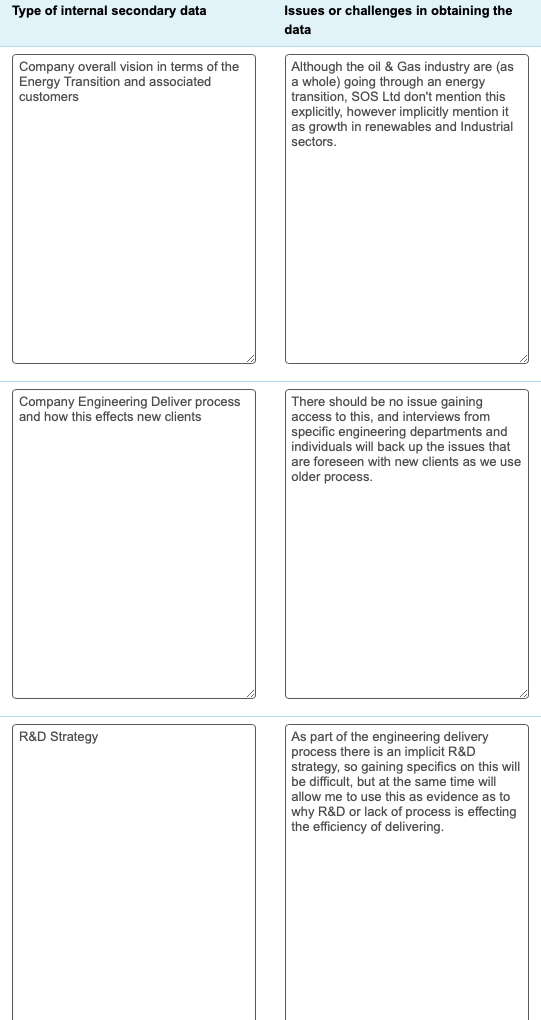
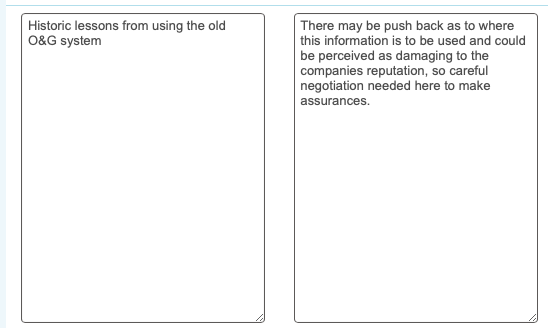
Top tasks for building trust:
1.Being open and Honest with research participants
2.Empowering others and collaborative process - keep them in the loop as to how its going.
3.Ethical behaviour
Maintaining Power relations within the organisation:
1.create an environment where an open dialogue is able (if you are superior)
2.Revisit Stakeholder map
3.Keep it as a interest for others to gain buy in
How does the organisation understand its aims and objectives?
SOS see its aims and objectives as that of servicing the Renewables, Industrial and offshore energy sectors through inspection services, hydraulic, maintenance and refurbishment of equipment. It's aim is to do this through growth acquisition and grow the industrial sector and renewables over oil and gas.
Do they miss anything important?
Yes, nowhere is the energy transition mentioned, it appears more of the same but growth to make it bigger, rather then 'what are we doing for the future?' Also Automation, Electrical Engineering is not mentioned at all and neither is innovation. I know for a fact that my department innovate and carry out R&D to satisfy new and older clients. We must Innovate during the energy transition but this is not really mentioned.
To what degree might your project help the organisation meet its aims and objectives?
I think, by utilising a more efficient method of innovation delivery, this can be marketed as another string in our bow as how we are progressing through a huge energy transition. Perhaps some are already asking what we are doing about this?
Who is affected by fulfilling or not fulfilling the stated aims and objectives and how can your project help in this regard?
Our clients are effected as some are likely unaware that we deliver innovation in some cases. Clients may have a problem that requires a solution but unaware my department are able to deliver this. My team are also effected as the current method of engineering delivery is rather outdated. Our clients are also, in some cases, not getting as efficient a service as they could, and are often going elsewhere.
Head of Engineering:
Has overall responsibility of all engineering within the company and is a main gatekeeper. His experience and knowledge is vital to the project as he has 15+ years experience and knows of the changes needed.
Electrical Engineering Team Lead:
A very sought out individual who is at the coal face when delivering engineering solutions. His input why the current state is not working and a new future state would.
Fluid Power Team Leader:
As above from a different aspect of engineering
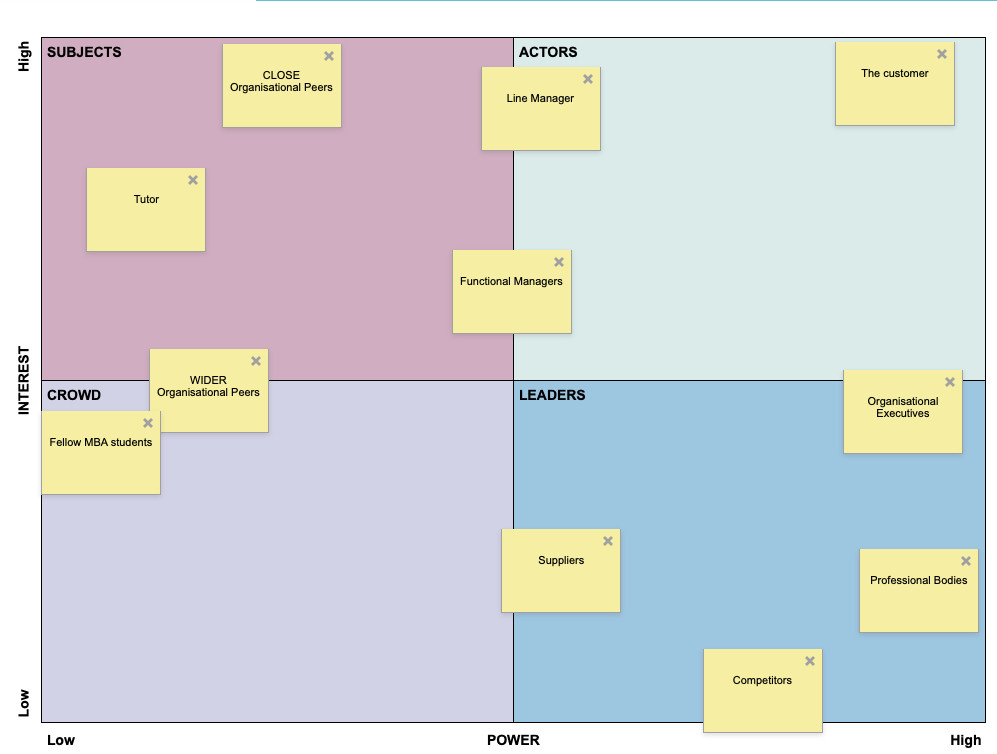
First Choice:
Customers or service users:
Without a doubt our clients/customers are the most important external stakeholder. Their feedback, say and input to design is why we win work.
Second Choice:
Professional bodies:
Changes in standards, best practice make a big difference to the design and ultimately, the safety of our customers.
Third Choice:
Suppliers:
Suppliers also contribute on an engineering level and so their input and also ability through the supply chain to deliver a quality product on time is essential
Two internal institutional Stakeholders that would be interested in my research are within two departments that would benefit greatly if a new, more efficient process was adopted.
The Electrical Engineering and Automation Department and the Overall Operations Department.
Electrical Engineering and Automation Department:
By making the change this will vastly improve the way in which engineering is delivered, its efficiency, and how it is delivered, meaning that overall, stress and demand on the department and each individual is reduced. Reputation internally will be increased and less demotivation as projects are able to go out on time and on budget.
Operations Department:
The operations department work closely with individual clients, it is in their best interest to ensure that other departments deliver, through them to their clients. If the engineering department cannot deliver on time this reduces reputation, revenue and confrontation internally.
The oil and gas industry is going through one of the biggest changes in its history. Whether it be the main, big oil extractors (BP, Shell etc) or oil and gas services companies, they are all effected by the ‘Energy Transition’
My organisation, being an oil and gas ‘services company’, like others, must respond with flexibility, speed, collaboration or, as has happened within my company, can lose out to the tide of digital companies who can often do it cheaper, more efficiently and at less cost.
The result is a very ambitious growth strategy, but unfortunately lacks the change needed to deliver engineering solutions to consider new market segments. Unfortunately, the use of old, outdated processes are being used causing inefficiency in delivery.
I have, therefore, used four steps to carry out my literature review:
STEP 1
Identifying topics to search for:
Firstly, it was in my best interests to note down what the problem is, document questions and sub-questions that can be answered by colleagues and through company research. Topics to search for would be around:
1/ How can SOS delivery future energy transition engineering solutions to new markets using outdated O&G related processes?
2/ How can we improve engineering delivery efficiency while a skills shortage, saturated market and resource issues exists?
1/ This allowed me to generate some sub questions that would help fine tune my literature searches. These consist, so far, of:
2/ Would upfront R&D investment allow new technologies to be designed (using an implicit R&D process)?
STEP 2
Searching for academic knowledge:
Using the OU Library, and other ‘quality’ sources (such as ‘Google Scholar’) a general review of ‘the problem’ was carried out and brought up a number of academic papers, dissertations and notes on efficient ways to deliver, based on theories taking into account the 4th Industrial Revolution, the fact that large organisations, such as the Oil and Gas Industry, the MOD and the nuclear industry are looking for cost effective, more efficient methods of delivering R&D and other such Engineering complexities.
STEP 3
Tunnelling this down to several contextual sources of knowledge was quite time consuming but allowed me focus on my organisations problem in delivering engineering solutions more cost effectively, and efficiently, as we go through the ‘Energy Transition’. These theories, frameworks and models were peer reviewed, formal documents and other sources of ‘quality’ information from non-academic sources.
This allowed me to gather information relevant to my project and help me define my project work problem.
STEP 4
As a result of Step 3, I then managed to round down my literature research to several documents (around 10 -15) which I then saved into a research folder structure as follows:
1/ Stakeholder Analysis
2/ Risk Management
3/ Change Management
4/ Culture
5/ Strategy
The above will allow me to use several concepts when questioning and from theory literature to produce a possible change model which can be presented.
I picked a subject on the energy transition and a theses named: The ongoing energy transition: Lessons from a socio-technical, multi-level analysis of the Dutch electricity system (1960–2004)
The theses is organised with an abstract, an introduction, a main body, conclusion and references
The main body of literature is organised thematically and numerically.
In the authors own words:
The energy sector faces serious problems, e.g. oil dependency, reliability and environmental problems. Large jumps in environmental efficiency may be possible with transitions to a new energy system (Weaver et al., 2000). Hence, NGOs and policy makers show increasing interest in transitions

The 'Three archetypes of the Open Innovation Process' (Gassmann and Enkel, 2004) is a theory that identifies with my organisation problem.
Three Archetypes of the Open Innovation Process (Gassmann and Enkel, 2004, p. 13) is an incredibly useful theory for my organisational problem. Here it argues that a 'closed' innovation approach, where, in terms of my organisation, all engineering solutions are developed in house, is fine if high risk is involved and you have a unique product. In terms of my organisation there is already technology out there that could be used to speed our innovation process up and reduce cost (an 'open approach'). Using a 'coupled approach' (aspects of in house development and partnerships) is something my organisation could use to make engineering delivery more efficient.
Other literature could be:
'Achieving synergy between strategy and innovation' Dobni, 2010 which addresses not just the technological aspect, but the infrastructure, market and the culture.
'Foundations of dynamic capabilities and business performance' Teece, 2009, which addresses the threats associated with making such a change.
Why delivering complex engineering solutions to new 'Energy Transition' market segments cannot use current outdated processes'
The oil and gas industry is going through one of the biggest changes in its history. Whether it be the main, big oil extractors (BP, Shell etc) or oil and gas services companies, they are all effected by the ‘Energy Transition’
This term has become a quango of sorts, but what does it really mean? According to SPGlobal it is ‘the global energy sector’s shift from fossil-based systems of energy production and consumption to renewable energy sources like wind and solar, as well as lithium-ion batteries’ https://www.spglobal.com/en/research-insights/articles/what-is-energy-transition
As a result, the oil and gas industry have major challenges ahead.
It must keep oil current oil and gas producing assets at 100% operability and consider the fact that oil and gas production is still rising. However, to keep competitive, operators need to do this at lower and lower prices.
At the same time they need to ‘envisage the future’ http://clareo.com/wp-content/uploads/2018/05/OilGasReport.final0420172.pdf
Envisaging the future will involve spending on capital expenditure, R&D and innovative technology to continue the extraction of oil that is becoming more and more difficult to get and also renewable industries.
My organisation, being an oil and gas ‘services company’, like others, must respond with flexibility, speed, collaboration or, as has happened within my company, can lose out to the tide of digital companies who can often do it cheaper, more efficiently and at less cost.
Although my organisation has, as a result, developed a new ambitious growth strategy to service the Industrial (Nuclear, MOD) and Renewables industries, the truth is; they are doing this on the back of old oil and gas processes and resource making it difficult to deliver on time and on budget. Recent new renewable clients, not used to the oil and gas processes and delivery have seen their engineering solutions delayed. Likewise, services companies, like my organisation, have ‘gone in’ and tried to deliver using old, out of date processes, set up for an [once] stable oil and gas industry.
So……What’s the problem?
To some, there may not be, and assumptions could be made that it is a competence issue, or under resourcing. Unfortunately, the fact is, my organisation is struggling to deliver engineering solutions on time and on budget, especially within these new market sectors.
Smaller companies and those who have had a ‘foot in the door’ within the renewables industry for years are delivering faster and cheaper. Contracts are being lost as a result.
Can it be fixed?
Yes…… This may be a bold statement, but it just needs time and a resource to analyse the problem and come up with a possible solution. An MBA student is therefore a great resource to use!
Using a mind map (see below) it is clear that one of the major problems is culture. As a result of my organisation employing many influencers that have been with the company for 15-20 years, the ‘not invented here’ (Peter, 1997) or ‘we’ve always done it this way’ rhetoric makes any change difficult and so ‘buy-in’ must be earned through trust and evidence.

The problem that faces the organisation is therefore:
‘How can Sparrows Offshore Services (SOS) Ltd deliver future energy transition engineering solutions to new markets using outdated Oil and Gas processes?
The answer is…. It can’t, or it can, but with difficulty, which can influence safety, staff morale, stress and reputation.
My project will, therefore, focus on a number of questions and sub questions, which I shall ask virtually and in person (interviews) to three engineering departments and the business development department. This will allow me to see where the main issues lie. These questions and sub questions can be seen below:
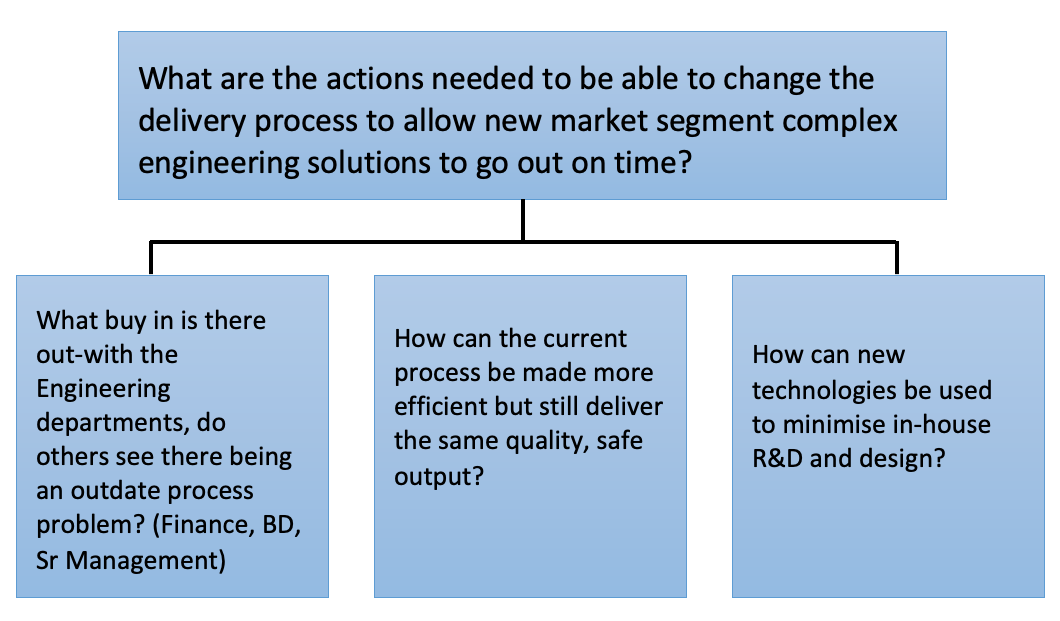
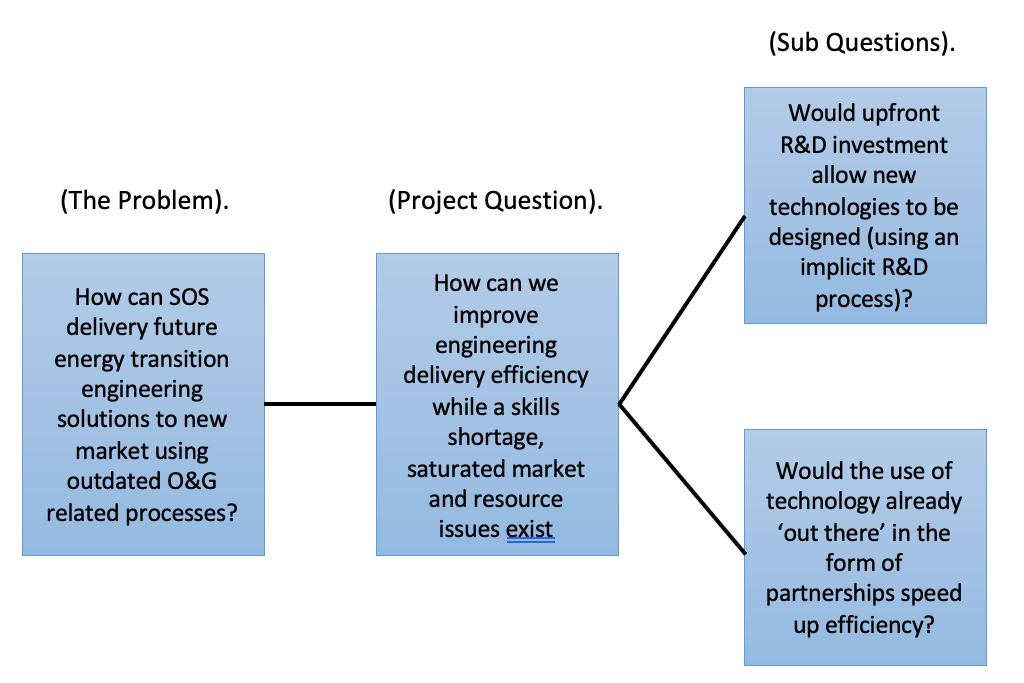
The results of the questioning will allow me to address what buy-in and cultural biases exist. Are there any reluctances to change and is this coming from senior management, middle management or from others?
The results will then allow a closer look at the current processes and whether they would benefit from major or minor changes to allow efficient delivery to our clients. Would technological advances already out there be utilised (partnerships) so that lengthy R&D time (using their implicit R&D process) is dramatically reduced.
This would lead to sub questions such as bridging the expertise, skills shortage? Can the use of outside organisations, consultants or internal department restructures solve the problem?
Could the R&D investment using an ‘explicit’ R&D strategy help develop next generation technology rather than putting the risk on our clients?
From these questions, the use of theories and frameworks can be used to evidence ways in which a new process may be mapped and presented to senior management. Such as:
Bartol, K.M. and Martin, D.C. (1998) Management, 3rd edn, Boston, Irwin/McGraw-Hill.
Holmes, A. (2004) Smart Risk, Chichester, Capstone Publishing Ltd
Teece, D.J. (2009) Dynamic Capabilities and Strategic Management: Organizing for Innovation and Growth, Oxford University Press.
Change management theories such as Oakland and Tanner’s Quality Management system could then be used as a method of introducing the change into the organisation.
3.5 Defining your work problem and developing it into a clear statement
As the oil and gas industry go through an energy transition away from the worlds reliability on fossil fuels, it does so by looking at technology and innovation and investing in this to ensure future renewable energy takes over from oil and gas. My organisation have therefore strategised an ambitious growth campaign over the next 5 years to ensure renewables and industrial markets are our main revenue streams. However, delivering complex engineering to these new market sectors is being carried out using outdated [oil and gas] processes which does not take into account upfront R&D resulting in late delivery and budget overruns.
What problems are you trying to find out?
How can improvements be made to the current outdated processes to allow efficient delivery in these new market segments.
Who are the target audience that you are interested in and report to?
The project will focus on three engineering departments, the business development department where the findings shall be shared with senior management within these departments. These findings will be used to generate a new, more efficient process in delivering engineering solutions.
Where does your project take place?
Both virtually and at my organisations premises in Aberdeen.
When are you starting and for how long?
6th December 2021 until February 2022
Why is it valuable to study this problem or change?
As a result of poor oil prices (until only recently), the pandemic, a skills shortage as a result of redundancies and some leaving during the Furlough scheme, delivering complex engineering solutions to our clients (and new market segment clients) has been difficult with delays, inefficiencies and budgets over runs as staff struggle to deal with this influx. This is compounded by the processes for delivering R&D and engineering solutions either none existent or out dated. Making a change to the delivery process to add efficiency would better moral, stress, our reputation and client satisfaction.
Rewritten statement
As the oil and gas industry go through an energy transition, away from the worlds reliability on fossil fuels, it does so by looking at technology and innovation and investing in this to ensure future renewable energy takes over from oil and gas. However not all organisations (including my own) have changed their structures, processes or engineering strategies to suit the new wave of technologies, clients and market segments that this will bring. This has resulted in budget overspends, rework, reputation, resource issues and moral problems as Engineers struggle to deliver using old processes. This is further compounded by there being an implicit R&D strategy. The project will therefore identify where the bottlenecks are and by the use of concepts, theories and frameworks come up with a more efficient process for delivery to senior management.
Having read Bell et al (2019) and Marx (1997) it is apparent that my statement of project research can be 'fine tuned'. By turning this into a research type statement, it can be fine tuned as follows:
'An exploration of how delivering complex engineering solutions in the new 'Energy Transition' market segments cannot use current out dated processes'
This also allows refinement of my sub questions, making sure they are researchable, and connected to established theories, these are:
Would an implicit R&D strategy and process help engineering delivery efficiency?
Would the use of technology already developed through partnerships or vendors speed up the design and therefore delivery process?
Would upfront investment in R&D technology out with a client Job help for future delivery?
Would the use of consultants allow processes/engineering shortfalls to be addressed, taking the pressure off the Engineers doing the work.


Using the mind map below, I was able to break down the context of my 'work problem' into 'The Problem', an 'Introduction and the background' of why this is a problem, 'what theories and frameworks', including evidence could be used to build on a solution and, of course 'The solution' itself, with conclusions, recommendations and summary.
See below for my mind map:

As a result I am interested in how my organisation will manage to deliver complex engineering solutions as they look to the future (post Energy Transition) and grow out of the Oil and Gas market, concentrating on Industrial and Renewable projects and customers. However, although the ambitious growth is talked about within my organisation, the move, away from dated oil and gas related older processes are not.
Therefore, the statement of my research project shall be:
'Why delivering complex engineering solutions to new 'Energy Transition' market segments cannot use current out dated processes'

Above is an extract from a SWOT analysis I undertook on my organisation in 2020. Carrying out a similar exercise on the Oil and Gas Industry, in particular Innovation and Technology, as a whole, shows similar outcomes.
Oil and Gas Industry -Innovation and Technology as they move through the Energy Transition
STRENGTHS:
The oil and gas industry was renowned for having the budgets and resource to carry out some amazing innovation and technological developments in order to extract oil and gas. These range from structural engineering (oil platforms), Electronics and electrical engineering (Automation and control systems for safety and operation of valves), Hydraulic and pneumatics.
The industry was (and is starting to become again) a culture of innovation and has some amazing talent with artefacts such as the premises, resource, training regimes and ability to deliver some amazing innovation as we transition away from fossil fuels.
The effort and enthusiasm that was originally put into early technology (1970’s and 80’s) to allow the extraction of oil is now starting to be seen in the transition to renewable and cleaner technologies.
Innovation in the oil and gas industry
The oil and gas industry are a very well-established industry which still has the workforce and skills needed to do well in the transition to other technologies. This also extends to partnerships and alliances, which, especially if engineering biased, can be used to investigate the next generation of technology needed.
My Organisation therefore need to update their engineering delivery process to allow for these new technologies and partnerships rather than using the older processes in force that were generated some 10-15 years earlier.
WEAKNESSES:
Due to a number of downturns and the global pandemic, where oil prices have dropped as low as $20 per barrel (2002, 2009, 2015 and Mar 2020) where profit making is difficult and investment in technology not seen as a priority, investment in technology has been slow since 2009. Now that we are back in the $85 a barrel region, investment is started to creep back and interested gained. This has spawned a culture that has been difficult to remove and so investment in up-front R&D difficult to gain access to.
https://oilprice.com/oil-price-charts/
https://www.macrotrends.net/1369/crude-oil-price-history-chart
‘A clear correlation between innovation and success in growing revenues across industries’
Innovation in the oil and gas industry
With this in mind my organisation will need to include technological and innovation as part of their long-term ambitious growth strategy and ensure business models and processes reflect this, especially as we venture into new territory. Current processes are more than 10 -15 years out of date.
Other, smaller companies are also encroaching into territory that my organisation were used to being the ‘go-to’. These smaller companies, with upfront R&D and associated delivery processes are able to compete by delivering more cost effectively.
https://maritimedevelopments.com/news/mdl-ame-awarded-crane-upgrade-scope/
OPPORTUNITIES:
My organisation has done the right thing and looked at the Industrial and Renewables sectors as future revenue streams, rather than complete reliance on the Oil and Gas Sector. As a result, there are numerous opportunities in the following fields:
Nuclear:
Currently my organisation has bid and are starting to win future contracts for electrical engineering work on nuclear power station sites and Nuclear Submarine Bases for the MOD.
MOD:
Work on crane automation and control systems within Royal Navy bases to support build and refurbishment programs on Royal Navy Submarine and Warships. Also numerous other electrical, hydraulic and mechanical engineering works.
Industrial Factories
Numerous factory automation opportunities exist within the food and drink industries on their automated factory floors.
Cable and Pipe Lay Systems:
Numerous engineering tensioner system rental for the installation and extraction of offshore and onshore windfarm power cables.
Renewables:
Numerous opportunities in windfarm blade inspections and electrical work.
To exploit these opportunities, my organisation needs to invest in R&D, partnerships and acquisitions with an Engineering deliverable process to suit that does not involve 100% in-house development.

Sparrows Offshore Services Marketing Mix 2020
THREATS:
As a result of smaller companies becoming competitors (oil and Gas sector) and the fact that my organisation is moving into sectors that will already have a long-established set of servicing companies, our market share could be jeopardised if we cannot deliver efficiently, which using our current out of date engineering delivery process, could cause reputational damage if not careful. These need to be changed to take int account R&D and the use of a ‘coupled approach’ (Gassmann and Enkel, 2004, p. 13)
Other threats could again be the economy and also the possible saturation of the very market share we are trying to exploit, as others also go through the energy transition.
My organisation also have a number of influencers within the engineering departments who have worked within my organisation for 15 – 20 years plus. This has cultural difficulties within the organisation where ‘change’ is difficult to gain buy-in, especially by these very people who wrote the original (now out of date) processes.
POLITICAL:
Sadly, the oil and gas industry is heavily influenced by politics. This has a major effect on the overall global oil price and supply, which the world heavily relies on as a fossil fuel burning planet. Politically this can cause numerous tensions between countries. A prime example is the tensions between Iran and the US. Such tensions, and similar, cause an increase in terrorist attacks and even wars, which have spiked since the 9/11 attacks.
(Derica Lambrechts & Lars B. Blomquist (2017) Political–security risk in the oil and gas industry: the impact of terrorism on risk management and mitigation, Journal of Risk Research, pp., 1320-1337)
Governments also have great influence on the oil and gas industry. This is as a result of the huge profits that can be made and control that can be asserted over this asset, especially if it is produced locally. Many countries will keep control of this asset through legal frameworks, contract enforcement, pricing regulations, taxes and Industrial safety.
(Howard L. Lax (1983) Political risk in the international oil and gas industry, International human resources development corporation, Boston, pp., 3-6
From an Environmental impact, none can be more damaging to the environment to that of the oil and gas industry and use of the by-product that currently powers our cars and industry. As COP 26 it is clear that the oil producing nations must look to the future and other forms of energy.
(OPEC Statement to the UN Climate Change Conference (COP 26/CMP 16/CMA3) https://www.opec.org/opec_web/en/press_room/6704.htm
[accessed online 16 November 2021]
The potential impacts that politics could play on my organisation are around the ‘Energy Transition’ and the fact that they are not yet set up to deal with the delivery of new technologies and clients. The organisation will exploit new ‘renewable energy’ clients but, as I write this, are not set up to effectively deliver. A recent industrial client win has proven this.
The other pollical impact is one of funding, grants and initiatives. In order to exploit these new renewable clients and technologies, funding in R&D, acquisitions and partnerships are a must, but this is proving slow to be granted with a fear that the organisation goes down the long-trodden path of ‘this is the way we have always done it’
ECONOMIC:
As the oil price starts to rise (https://oilprice.com) the top oil producing countries in the world; USA, Russia, Saudi, Iraq etc (https://www.worldometers.info/gas/gas-production-by-country feed the top oil consuming countries, USA, China, India, Japan etc (Aljazeera, 2021). Any economic decline in any of these countries usually has an impact on the oil and gas industry. For instance, oil prices fell in the first week of August 2021 as the growth in factory activity in China slipped sharply (Aljazeera, 2021). The oil and gas industry also supports jobs globally. High oil prices means more recruitment and many more in jobs, however, it impacts other industries negatively as oil prices push fuel prices up. A countries inflation will also impact this as fuel prices rise in line with other domestic goods and services.
SOCIAL:
The Oil and Gas industry is going through a huge change as it progresses the ‘Energy Transition’, this has only brought it’s [negative] image back to the forefront as a huge polluter. This image effects everything! This image is being exploited by many of the big oil companies as they promote their move to greener, renewable energy.
(OPEC Statement to the UN Climate Change Conference (COP 26/CMP 16/CMA3) https://www.opec.org/opec_web/en/press_room/6704.htm
[accessed online 16 November 2021]
Cultural trends are being affected [even before the energy transition] as developing countries see an increase in their population buying automobiles. On the flip side, many cultural trends are pushing toward greener, renewable energy and so customer buying trends are shifting to electric cars, greener energy (solar, wind).
My organisation, although wanting to move to renewable energy as their primary revenue stream and servicing these clients, it has done so, arguably to make up for the loss in revenue that is likely as the transition occurs. My project will aim to ensure that an engineering process is in place to allow delivery of complex engineering solutions, rather than trying to use the existing older Oil and Gas related systems that are currently in place.
Customer buying trends have also changed dramatically since the financial crash of 2009, which also caused a oil and gas down turn. I have found that our clients want value for money, efficiency, and projects to deliver on time. Smaller companies are coming online that can deliver more efficiently.
TECHNOLOGICAL:
As my organisation chase work outside the usual Oil and Gas industry it is clear that the renewable industry and industrial (including the MOD) are looking for contractors outside their normal 'go to' organisations in an attempt to get more Commercial Off the Shelf (COTS) equipment. Defence Contracts Online, 2020,https://www.contracts.mod.uk/do-features-and-articles/cots-increasing-land-capability/
As a result, my organisation have been approached and have started to win contracts within this 'industrial' field. This is outside the 'norm' for these organisations and also mine, who would expect to deliver. As a result, producing goods and services cannot be carried out, entirely 'in-house' we do not have the expertise to deliver. As a result the classic old delivery process has to be updated to accept the use of partnerships and outside technological help from other companies. This 'coupled' approach (Gassmann and Enkel, 2004) would ensure the expensive, slow process of R&D could be avoided.
Other companies out there will already have developed some of the technology being asked for and are often at the forefront of emerging technology.
ENVIRONMENTAL:
The oil and gas industry is a major polluter, not only in the extraction of oil and gas but as result of its use in heavy industry, aviation and automobiles worldwide. This is a major source of airborne particulate matter and a key contributor to the mortality and disease.
https://www.wilderness.org/articles/blog/7-ways-oil-and-gas-drilling-bad-environment
Karn Vohra, Alina Vodonos, Joel Schwartz, Eloise A. Marais, Melissa P. Sulprizio, Loretta J. Mickley: Global mortality from outdoor fine particle pollution generated by fossil fuel combustion: Results from GEOS-Chem, Environmental Research, Volume 195, 2021, https://www.sciencedirect.com/science/article/abs/pii/S0013935121000487
Health is not the only aspect of this by product, but also climate change where global environmental legislation is being pushed froward as the industry go through the energy transition .
(OPEC Statement to the UN Climate Change Conference (COP 26/CMP 16/CMA3) https://www.opec.org/opec_web/en/press_room/6704.htm
[accessed online 16 November 2021]
My organisation is, therefore, looking to exploit technologies through growth in the renewable and industrial sectors to promote their business ethics to show they are moving away from fossil fuel type operations and moving to the renewable energy.
https://www.sparrowsgroup.com/news-and-updates/sparrows-group-wins-large-contract-in-defence-sector
https://www.sparrowsgroup.com/renewables
LEGAL:
At the top of any Legal agenda is ‘safety’. The Oil and Gas industry have always been safety conscious. This is evident in the very long design process that my organisation go through when designing engineering solutions. This can often be very time consuming before the first ‘parts’ are fabricated or built. Many clients (non engineers) can find this quite frustrating and will often question the timelines. Piper Alpha and The Deepwater Horizon are worst case scenarios of why health and safety are so important. That said, there are still more efficient ways of delivering this portion of a solution to a client. Product Safety, and the design of this does not always HAVE to be carried out in-house, there are partnerships and outside companies that can assist in helping develop a solution. This delivery process is what my project will focus on, rather than carrying out the entire R&D part in-house. As automation and electrical systems become more common place, more legal standards and processes are required to design and deliver a ‘system’ to what is best practice.
Different countries have different acts that govern the oil and gas industry e.g. the Petroleum Act in the UK, Federal Oil and Gas Royalty Management Act, Resource Conservation and Recovery Act in the USA, and the Petroleum and Natural Gas Rules in India.
https://www.legislation.gov.uk/ukpga/1998/17/contents
https://uscode.house.gov/view.xhtml?path=/prelim@title30/chapter29&edition=prelim
By the use of partnerships and a coupled approach to engineering, competitive legislation and the need to carry out patents and keep IP is simplified.
With reference to Unit 1 - Session 2, Activity 2.4, there are a number of questions that can be answered in order to justify my Organisational Context.

As a Chartered Engineer and Manager within a medium sized Oil and Gas company, this is a subject close to my heart; that of Technology Innovation and ensuring it is delivered to the highest standard, safely, on time, and fit for purpose. However, this ‘wish list’ is becoming more and more difficult to achieve, especially as we enter (or arguable, have entered) the 4th Industrial Revolution. But does it have to be so difficult?
As I write this complacency and obsolescence within the industry is an issue that involves a lot of resource to keep operating. Contracts that require the update of technological systems are often fraught with delays and budget issues. This is because of an insistence to develope the solution entirely in-house from the ground up utilising a reduced workforce and a perception that it will bring in more revenue. Sometimes, companies already exist that have a solution, in part, or even all of the technological solution needed. Research and Development, innovation and delivery strategies therefore need to change from the old pre downturn and pandemic days to suit the future 4th industrial revolution and the need to move to renewable, sustainable projects as the world weeness itself off fossil fuels.
Making change in an organisation that has cultural behaviours driven by influencers who have been employed within my organisation for over fifteen years, makes this change more difficult. Changing an engrained culture over a short period of time is a challenge and so my role will be initially as the instigator for the need for change using evidence of past history as evidence. I will then champion the change by using concepts, theories and frameworks that could be used, modified, or discarded so that a hybrid system is eventually developed that will meet our needs. This will utilise resource needed to implement and police, systems and controls that could be put into place and all considering the various behaviours that will influence its direction and eventual success. My role will also make sure I am there, from start to finish, keeping it on track.
To sell the need for change, within my organisation, and then eventually instigate and lead the change, theories, concepts, and frameworks will be used to help sell what is ‘best practice’. This will help sell change to the organisation’s influencers and other actors in such a way that they do not perceive the change as only my opinion. Theories, concepts, and frameworks will also attempt to show what is ‘best practice’ through peer reviewed research.
Examples of such theories, models and frameworks are:
Dodgson, M., Gann, D. and Salter, A. (2008) The Management of Technological Innovation, Oxford, Oxford University Press.
George, Gerard and Bock, Adam J (2011) ‘The Business Model in Practice and its Implications for Entrepreneurship Research’, Entrepreneurship theory and practice, 35(1), pp. 83–111.
Freeman, C. (1987) Technology policy and economic performance: Lessons from Japan, London, Pinter.
Oakland J.S and Tanner, S.J. (2006) ‘Quality management in the 21st century – implementing successful change’, International Journal of Productivity and Quality Management, vol. 1, no. 1-2, pp. 69-87.

Teece, D.J. (2009) Dynamic Capabilities and Strategic Management: Organizing for Innovation and Growth, Oxford University Press.

Tidd, J. and Bessant, J. (2009) Managing innovation: integrating technological, market and organizational change, Hoboken, NJ, Wiley.
Schein, E. H., (1984) ‘Coming to a new awareness of organizational culture’, Sloan Management Review, 25:2, pp. 3-16.
Schmidt, R., Lyytinen, K., Keil, M. and Cule, P. (2001) ‘Identifying software project risks: an international Delphi study’, Journal of Management Information Systems, vol. 17, no. 4, pp. 5–36. [Online].
Holmes, A. (2004) Smart Risk, Chichester, Capstone Publishing Ltd.
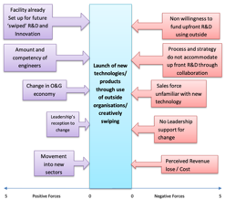
Bartol, K.M. and Martin, D.C. (1998) Management, 3rd edn, Boston, Irwin/McGraw-Hill.
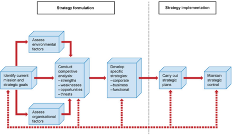
The idea is, therefore, to cover a number of theories using the above, which should cover - Stakeholder Management, Politics’, Corporate Finance, Risk Management and Culture.
This blog might contain posts that are only visible to logged-in users, or where only logged-in users can comment. If you have an account on the system, please log in for full access.